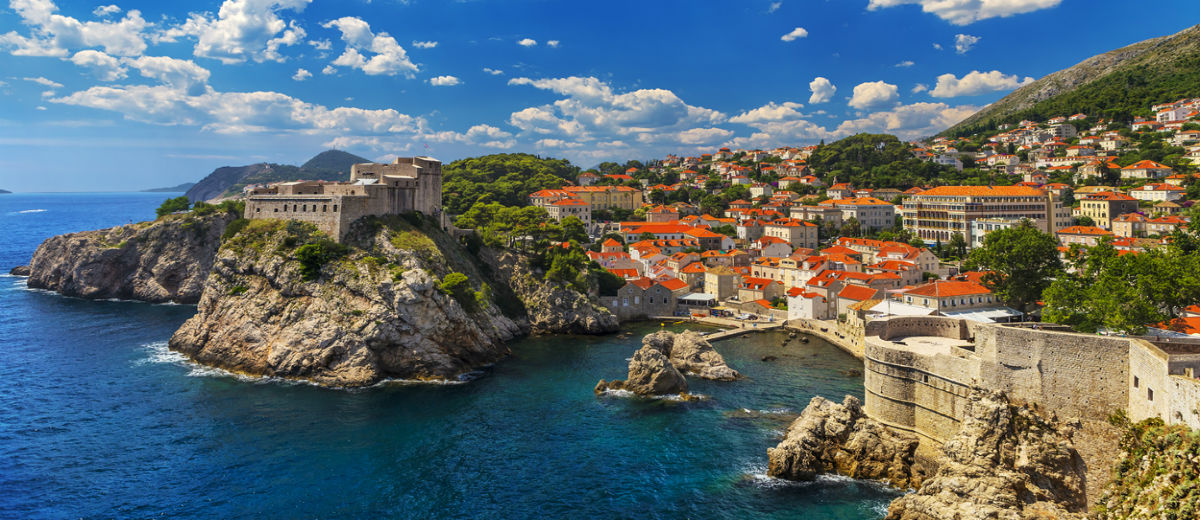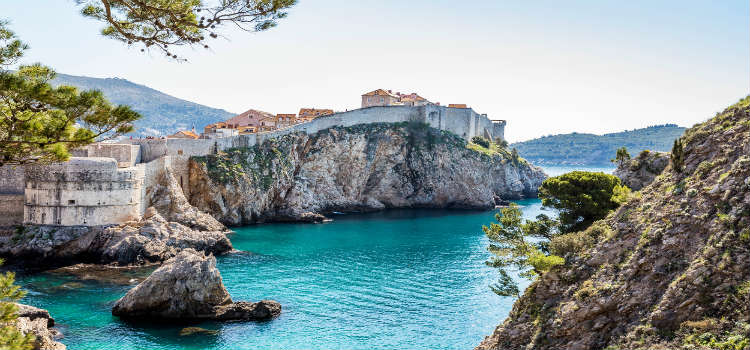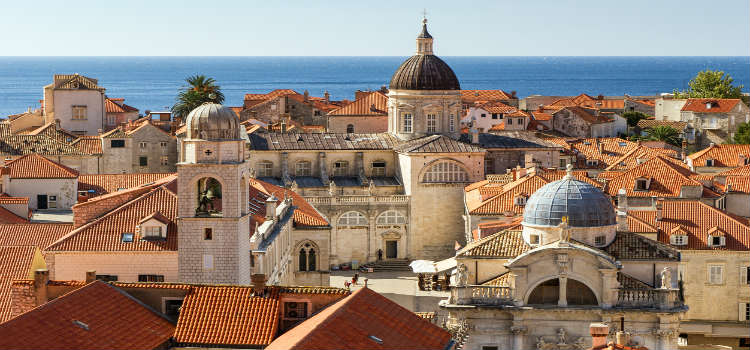

Dubrovnik Old Town is one of the world’s most beautiful walled cities and the glimmering Dubrovnik Riviera outside the city is one of the most interesting places to stay in Europe. The poet Byron dubbed Croatia’s southernmost city “the pearl of the Adriatic” – and it certainly gleams against the deep blue sea. The old town is a knot of limestone streets – worth getting lost in, to stumble upon elegant palazzi and baroque churches. Beyond the sturdy medieval fortifications is a stunning rocky coastline, dotted with pebbly beaches, while islands cast adrift from mainland Croatia are just ready to be explored. Read on for the ins and outs of the city with our Dubrovnik travel guide.
The best time to visit Dubrovnik is May to June or September to October: it’s as warm but not as crowded, or expensive, as July and August – when hotel prices skyrocket. November to April visits can be lovely too, but many facilities close and the weather can be unpredictable.


British Airways, EasyJet and Jet2 fly from the UK to Dubrovnik in summer. It takes around 2.5 hours to fly from London and just a little longer from other UK airports.


Unsurprisingly, due to Dubrovnik’s Adriatic-hugging location, seafood features heavily on the menu. The best places for fresh fish are Orhan, a waterfront restaurant by Fort Lovrijenac, and the historic Proto, a local institution since 1886. For classic Dubrovnik food, try traditional dishes like kopun (castrated cockerel in honey and wild orange) or pasticada (wine-stewed beef and prunes with gnocchi) at the restaurant, Kopun. The vineyard-blanketed Pelješac peninsula produces some of the nation’s finest red wines from the Mali Plavac grape – sample local favourite Dingač at Matuško winery near Potomje.
Island-hopping is one of our favourite things to do in Dubrovnik. The tiny Lokrum islet is a lush nature reserve of pines, palms, and cacti, just a 10-minute taxi-boat ride from the old harbour. Explore an abandoned 11th-century Benedictine Monastery, climb the 19th-century Fort Royal for panoramic views, sunbathe on smooth rocks or dive into the crystalline sea. Alternatively, get a taxi boat from Gruž port to the Elaphiti islands – Koločep, Lopud, and Šipan, for the best kayaking, swimming and snorkelling spots.
Banje Beach is one of the most popular Dubrovnik beaches, with glorious views of the city walls, rentable sun beds, water sports facilities, and a bar. However, it does get crowded in summer; try tranquil local favourite Sveti Jakov or secluded swimming spot Danče Bay instead. For an idyllic island hideaway, Šunj on Lopud is one of Croatia’s rare sandy beaches – and one of the best beaches in Dubrovnik.
Dubrovnik has a rich history, as seen in its Roman, Byzantine, and Venetian influences; it’s withstood sieges and wars and bounced back with vigour. In the 16th century, the city (then Ragusa) had vast naval power, with over 180 ships and 4,000 sailors – documented in the fascinating Maritime Museum. More recently, the brutal 1990s Balkan conflict saw Serbian and Montenegrin forces occupy the city. The War Photo Limited gallery’s permanent collection traces the bloody break-up of Yugoslavia, along with temporary exhibitions of photojournalism from global war zones.
Game of Thrones (GoT) fans can step inside a filming set in Dubrovnik. The 15th-century Rector’s Palace, which houses the city’s Cultural History Museum, was used as the atrium to the Spice King’s palace in Qarth. Just outside Pile Gate, the 13th-century Fort Lovrijenac – the Red Keep in GoT – is perched atop a rocky outcrop by Pile Cove – the drama’s ethereal Blackwater Bay.
• Take a day trip to Cavtat, a classical town founded by the ancient Greeks. It’s spread across a pine-strewn peninsula, with a pebble beach and natural harbour, but the main draw is the Art Nouveaux Račić Mausoleum by sculptor Ivan Meštrović.
• Buy krema od ruža, a natural rose face cream made using a secret medieval recipe, at Ljekarna Male Braće, an old working pharmacy inside the Franciscan Monastery.
• Just past St Peter’s Bastion, along the city walls, look down to see a bar terrace cut into the rocks: Buža, one of Dubrovnik’s best watering holes. To find the bar, climb the baroque staircase at the end of Gundulićeva Poljana, and look for the small sign by a tiny doorway in the wall.
• One of our favourite things to do in Dubrovnik is to hop on a boat to Mljet, a pine-cloaked island northwest of the city. While most visitors stick around Pomena, the rest of the island is unspoiled – cycle around the two interconnected lakes (12km) or kayak across the turquoise waters.
Ask any seasoned traveller what to do in Dubrovnik and they’ll say: wander the medieval city walls. The one-mile circuit is punctuated with bastions and towers – the highest, Minceta Tower, offers views across the rooftops. The best time to visit is early evening when it’s quieter, and the magnificent ramparts glow in the setting sun.
The 17th-century Baroque Cathedral houses an impressive collection of rare ornate reliquaries such as the skull of city patron St Blaise, and gold vessels from Byzantium, Venice and the Orient.
Just off Stradun, which is the main thoroughfare, lies the Franciscan Monastery. A 14th-century cloister is arranged around a shady courtyard peppered with orange trees, while paintings of Dubrovnik before the earthquake of 1667 are hung inside. There’s a traditional pharmacy with concoctions made using age-old recipes.
For one of the most scenic things to do in Dubrovnik, jump on the city’s cable car to ascend 1,300ft up Mount Srđ. At the top is the ruined Napoleonic fort where the Croatian army sought cover during the 1990s conflict. Today, it’s home to the Homeland War Museum, which displays maps, memorabilia and chilling footage. Note: Dubrovnik Cable Car is temporarily closed; try a buggy safari instead.
Our collection of places to stay in Dubrovnik Old Town puts you in the heart of the action, or choose a home on the Dubrovnik Riviera near one of the sleepy seaside villages, a short walk to one of the beaches that dot the coastline or nestled in the hills. Use your villa as the ideal base to explore everything the region has to offer (now you’re in the know after reading this Dubrovnik travel guide!), and as a retreat when you’re ready to rest and recharge. Whatever you’re looking for from your holiday to Dubrovnik, our concierge team is on hand to sort out any extras you’d like – from maids to local in-house chefs, and anything else you fancy!
11 reasons you need to visit Croatia
The four best drives across the Mediterranean Coast
We don't usually associate Britain's southeast shores with beautiful beaches – but if you know… Read More
The Costa Brava is beautiful, brilliant and beguiling all at once, but it's very often forgotten… Read More
Gorgeous beaches and hidden coves, picturesque towns and stunning scenery - Croatia has everything you could possibly… Read More
Tuscany is awash with idyllic charm - everything from the architecture to the landscape is… Read More
With arresting scenery and sparkling Mediterranean coastline, the Spanish region of Costa Brava ticks all… Read More
It's near impossible to imagine France without thinking of the Eiffel Tower sparkling in Paris… Read More